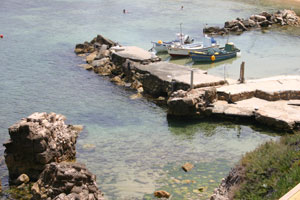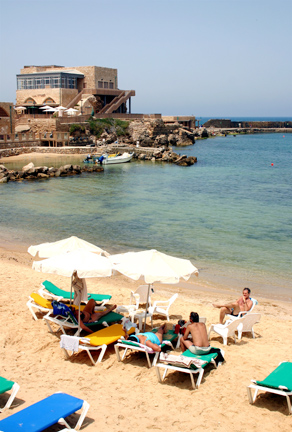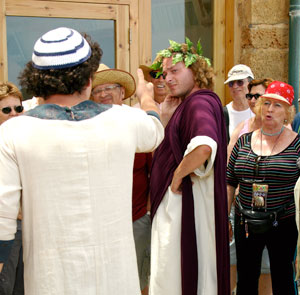CAESAREA, ISRAEL - An elderly man peered into the “looking glass of history” and began to ask a ghostly figure questions. The figure, dressed as King Herod, said nothing. Frustrated, the man asked his question in a louder voice, thus attracting the attention of a guide named Vered Bavli.
“You told me he would answer my questions,” the man protested to Bavli, “but he says nothing.”
She patiently reminded the man he was supposed to touch one of the 15 pre-programmed questions on a monitor of the interactive “looking glass” (a hi-tech computer and the only one of its kind in the world) which allows visitors to the ruins of this ancient port city a chance to talk to the historical characters (played by actors) who once ruled here.
“I have seen people scream at the screen before realizing they first had to touch one of the questions to get an answer,” said the charming Bavli.
The “looking glass” is just one of the fascinating ways the people who now rule over Israel’s Caesarea National Park recreate the events that took place here over time, beginning with King Herod’s decision to build this sprawling complex during his reign, which lasted from 36 BC to 4 BC.
“We are very proud of this technology,” said Bavli of the “looking glass” computer, developed in Israel and now highly sought after by other museums around the world.
“We are also proud of our Time Tower and movie that retraces the history here. But don’t blink or you may miss a century or two,” laughed Bavli about the short 10 minute film that spans over 2,000 years of Caesarea’s history.
One person who gave the short Caesarea film two thumbs up was Star Wars creator/director George Lucas, who made a surprise visit to the site a few years ago.
“We were told a very important person would be visiting the park and when we realized who it was, we were thrilled. Especially when he said he liked the film,” said Bavli as she led a small group up some stairs to the Time Tower, which overlooks the once mighty harbour built by Herod, the last king of Israel, to impress his Roman friends, who included none other than Caesar Augustus, for whom the port city was named after.
Some jagged honeycomb-coloured stones sticking out of the azure harbour water and the outline of the once mighty break wall built during the 12-year construction of this artificial port are the only reminders left that this was once one of the most powerful cities in the world.


Above: The beach at Caesarea is still used to by modern-day bathers.
A slide show in the Time Tower fills in the blanks and recreates a handsome city which, among other things, featured a massive Roman temple, Herod’s summer palace, a mini 9,000-seat Roman Coliseum and a hippodrome where chariot races and blood sports kept the Roman legions entertained. Once completed, the massive port, which contained an outer, middle and inner harbours, held up to 100 Roman warships.
Remains of the aqueduct used to transport drinking water to the city can also be seen from the Time Tower. They remain pretty much intact, their impressive arches used today by 21st century bathers as protection against the blistering Mediterranean sun.
After Herod’s death, the city eventually fell under Roman rule for a few centuries. A stone tablet unearthed here during excavation work indicates Pontius Pilatus once lived in Caesarea. The city also lived through Byzantine and Arab eras before the Crusaders finally arrived to discover what they believed was the Holy Grail here.
“Beneath the Time Tower is where the Crusaders kept their prisoners,” said Bavli pointing to a deep black hole covered now by a glass floor. The Crusaders, who ruled Caesarea between the 12th and 13th centuries before being ousted by a mighty Muslim army, also added a defensive wall around the city, part of which can still be seen today.
As we left the Time Tower to explore the sprawling port site, two actors, one dressed as King Herod and another as one of his subjects, kept a group of tourists entertained with a lively debate about the king’s friendship with the Romans.
“Not surprisingly, Herod always wins the argument,” smiled Bavli, who soon will head up the park’s newest attraction, a kid-friendly discovery project where they can play with Roman weapons and create their own fortress using huge building blocks.
“The kids will also cash in their schkels (Israeli currency) and get Roman coins in return to buy things,” said the guide.
After years of neglect, a few battles and an earthquake or two, Herod’s mighty Caesarea fell into the sea – the spot where the king’s palace and hippodrome once stood are clearly visible today, however.

Above: Actors playing Herod and his subjects entertain tourists.
The king’s impressive summer palace, which jutted out into the sea, came with a huge indoor swimming pool and the tiles that once surrounded it are still intact – covered today by sand to protect the delicate pieces of history from the blistering sun.
“Herod used the pool to entertain his Roman friends but history also tells us he liked to drown his enemies in pools,” said Bavli, who did not know whether any drowning took place here.
Part of the hippodrome still stands today. It was here that Ben Hur-type chariot races were contested – the winners were the ones who survived.
“The floor of the hippodrome was covered in sand to soak up the blood when one of the chariots rolled over and killed its rider,” said Bavli.
The hippodrome was later turned into a stadium where unfortunate victims were pitted against lions and crocodiles. According to the informative guide, Herod also started the Olympic tradition of awarding gold, silver and bronze medals here.
Part of the Roman theatre has been reconstructed and while it in no way resembles the three-storey masterpiece it was in the city’s heyday, today’s 4,000-seat complex with the Mediterranean Sea backdrop still looks pretty impressive. It’s now used for concerts and the original dressing room, complete with stone wash basins, is still intact and functional.
Remains of once mighty marble columns and a collection of impressive statues lie scattered about the theatre area, giving the grounds a graveyard feel.
The main street of ancient Caesarea stretched for many kilometres. A small part of the marbled street was unearthed during excavation work a few years ago and some impressive headless statues – one made of rare purple marble – were found during that dig. Both are on display a short drive from the main port.
“There are many other treasures of ancient Caesarea yet to be uncovered,” said Bavli, “but excavation work costs a lot of money. In fact, a good portion of Caesarea’s main street lies beneath the highway you drove on today.”
Modern Caesarea stays true to its ancient roots. The upscale city remains one of the most desirable places in Israel to call home. And, not surprisingly, the modern city comes complete with some luxury trappings, like one of the country’s two golf courses and the aptly named Caesar spa.
The modern day spa facility, featuring 20 treatment rooms, a Turkish bath, steam rooms, outdoor lounging areas with hot tubs and whirlpools would have fit quite nicely into ancient Caesarea.
“Why did Herod build his port here?” an English tourist asked Bavli.
“Why ask me,” she responded, “when you can ask the computer.”
Information
- Caesarea is an hour’s drive north of Tel Aviv. It’s easily accessible along super highway No. 2. Go to
www.goisrael.com. to find out more about Israel tourism.